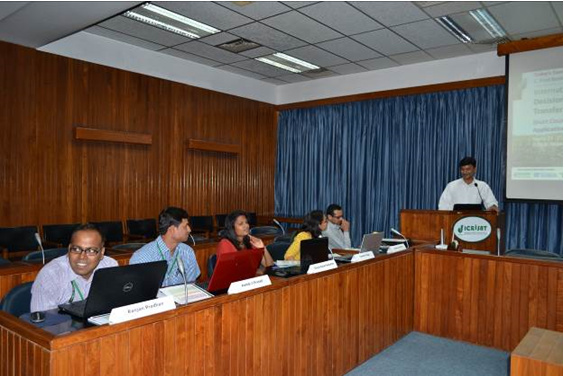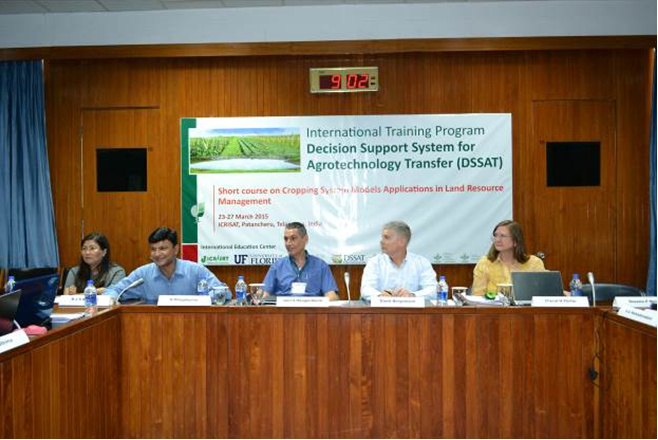The potential of crop models for understanding agricultural decision-making: insights from a DSSAT workshop (ASSAR South Asia)

By Hussain Ebrahim, Divya Solomon, and Chandni Singh

Above: Participants of the DSSAT training at ICRISAT campus, Patancheru, Hyderabad, India
ICRISAT, along with the DSSAT team in the University of Washington and University of Florida, conducted a week-long training session on cropping model systems from 23-27 March, 2015. This training was conducted on the ICRISAT campus in Patencheru, Hyderabad and focused on providing an understanding of simple agricultural modeling systems, particularly DSSAT. It focused on a hands-on approach to modeling to provide a holistic understanding of modeling as well as practical understanding of model usage. It also addressed the applicability of crop modeling systems to climate-change scenarios. The distinguished list of instructors included Dr. Gerrit Hoogenboom – Director of AgWeatherNet and Professor of Agrometeorology of Washington State University – and Dr. Cheryl Porter – a University of Florida software professor who has worked extensively with the DSSAT tool. Dr. Dakshina Murthy and Dr. Piara Singh from ICRISAT served as resource personnel.
Three members from the ASSAR South Asia team attended the workshop; Hussain Ebrahim (PhD student, ATREE), Chandni Singh (Postdoctoral Researcher, IIHS) and Divya Solomon (Researcher, ATREE). Other participants were from national- and state-level agriculture research institutes, and from various CGIAR organizations. Most of the participants were trained in different agricultural sciences and the ASSAR team introduced some interdisciplinarity.
The training began with an introduction by Dr. Peter Carberry, Deputy Director General, ICRISAT who gave insights into the growing importance of crop modeling, especially in the face of climate change. He also cautioned that interpretation of model results must factor in the uncertainty and assumptions involved and must be communicated to all end-users, from farmers to policymakers. Most of the participants had already worked extensively on the DSSAT tool. Although we had the least experience in using DSSAT, we went forward eager to learn.
During the initial sessions, Dr. Hoogenboom and Dr. Porter led us through an intensive brainstorming of unfamiliar concepts of plant physiology and climatic factors. The conceptual working of the model was also detailed. At the end of the session we could articulate relations amongst growth, yield and optimization of farm inputs into various hypothetical contexts (with and without climate change).

Above: ASSAR South Asia participants in the workshop
On the third day we moved from estimating and calibrating crop-genetic coefficients to water-limited production. We explored concepts of soil nutrient, water dynamics and nitrogen limited growth, which enabled us to efficiently simulate ground realities. The model’s ability to understand and incorporate complex biophysical processes such as evapotranspiration losses and nitrogen leaching were also explored. Model calibration, handling risks and uncertainties towards system sustainability and best management practices, made us realize how models can help understand complexities within agricultural systems allowing for more informed decision making. Seasonal exercises and crop rotation/sequence runs helped in understanding practical decisions in cropping, irrigation, fertilizer application and harvesting.
The course widened our perspectives on the applicability of crop modeling within our own research, particularly in the context of testing farmer adaptation options to climate change impacts. The more experienced participants could critically reason the modeling process and contributed to our deeper knowledge of the model’s limitations. The closing session included a presentation regarding ICRISAT’s newly launched online learning platform One Agriculture and closing remarks by Dr David Bergvinson, Director General, ICRISAT who emphasized the importance of crop modelling systems, particularly in informing farmer decisions.

Above: Concluding session on Day 5. Dr David Bergvinson (second from right), Director General, ICRISAT gave closing remarks.
Longer, more extensive training would be interesting to those planning to use this framework. This training served as the basis for the AgMIP training that was held in Bangalore the following week. We hope to use some of the skills learnt in this training in the agricultural socio-ecological systems in the ASSAR research sites in India over the next few years.